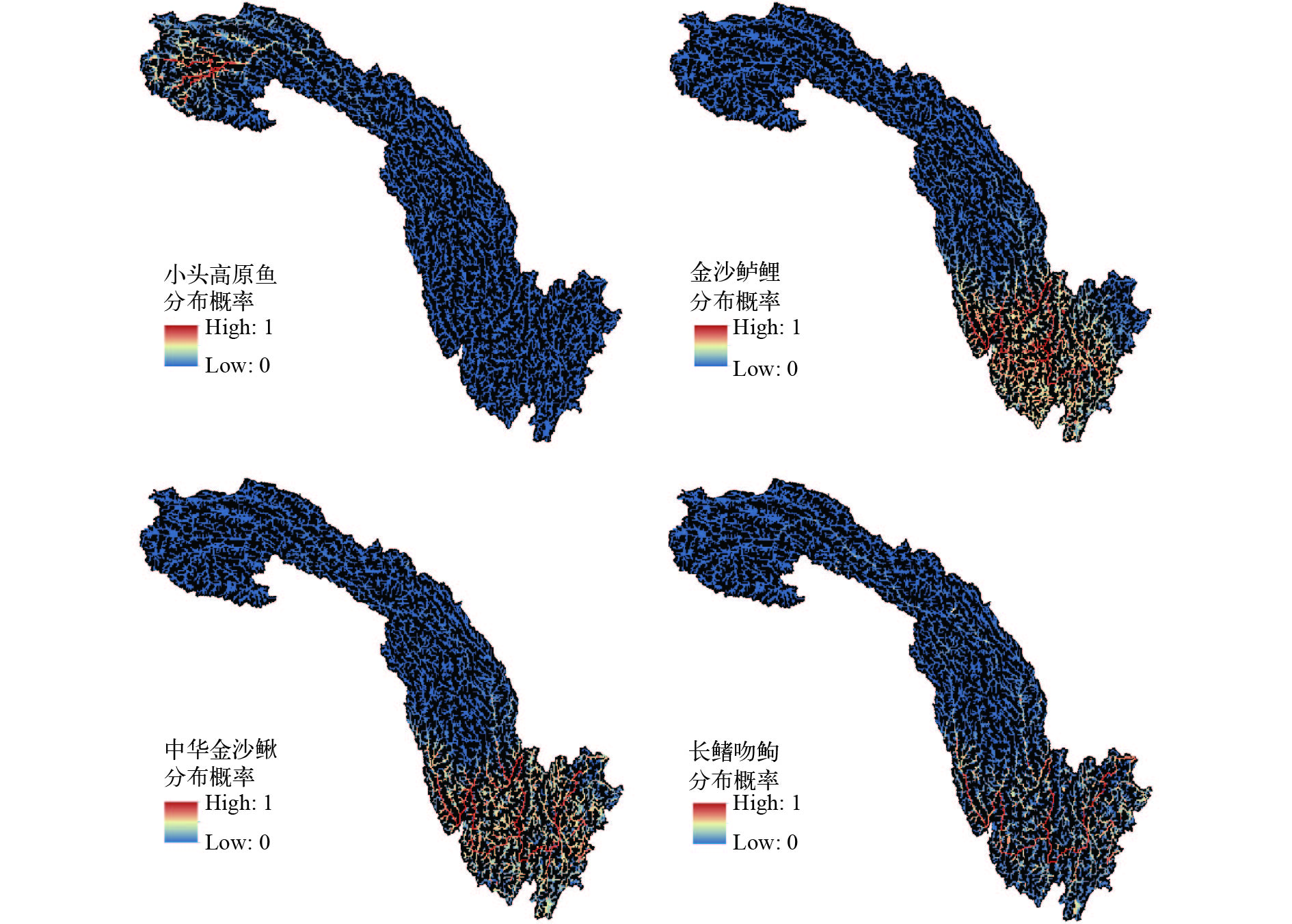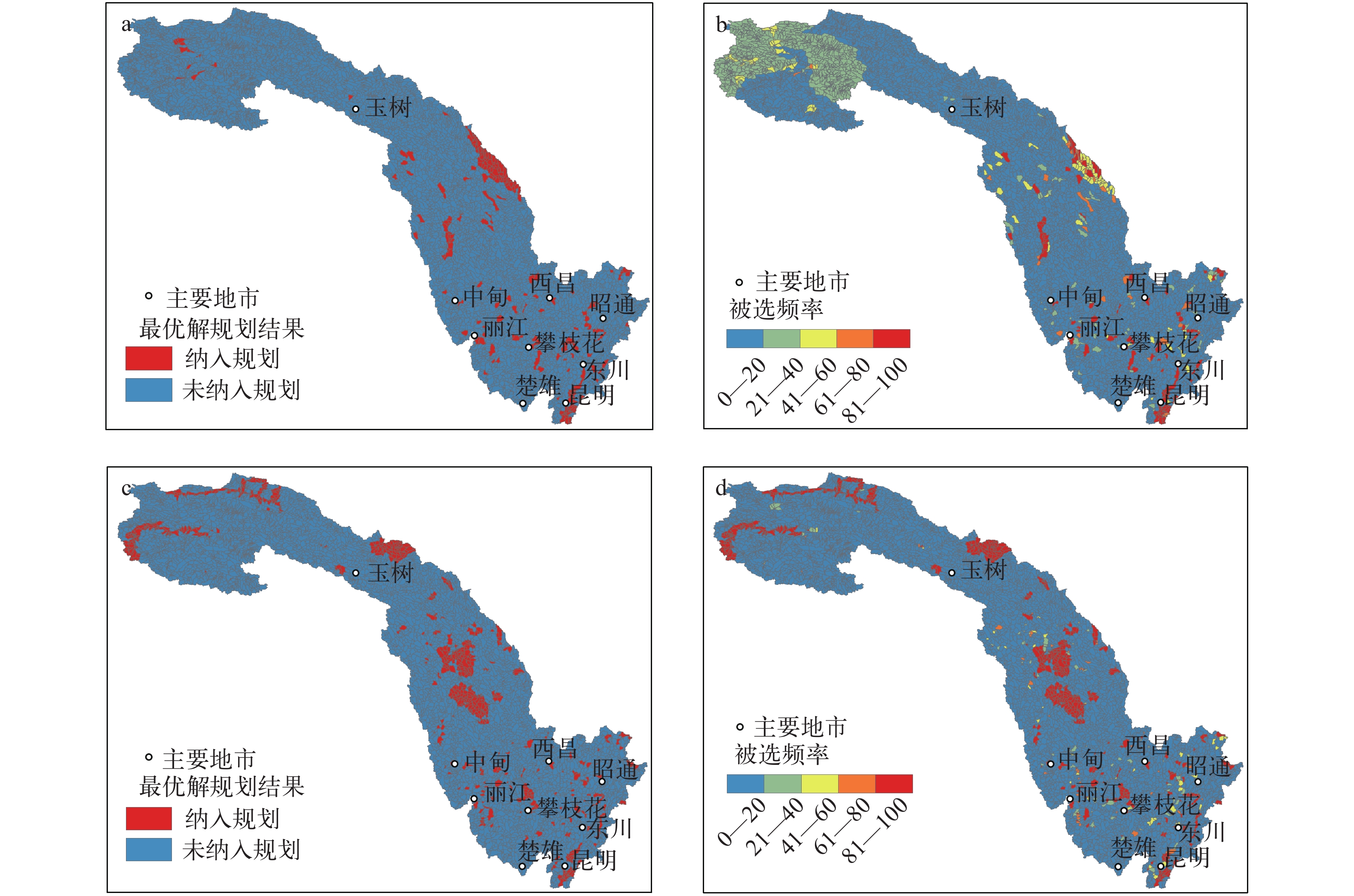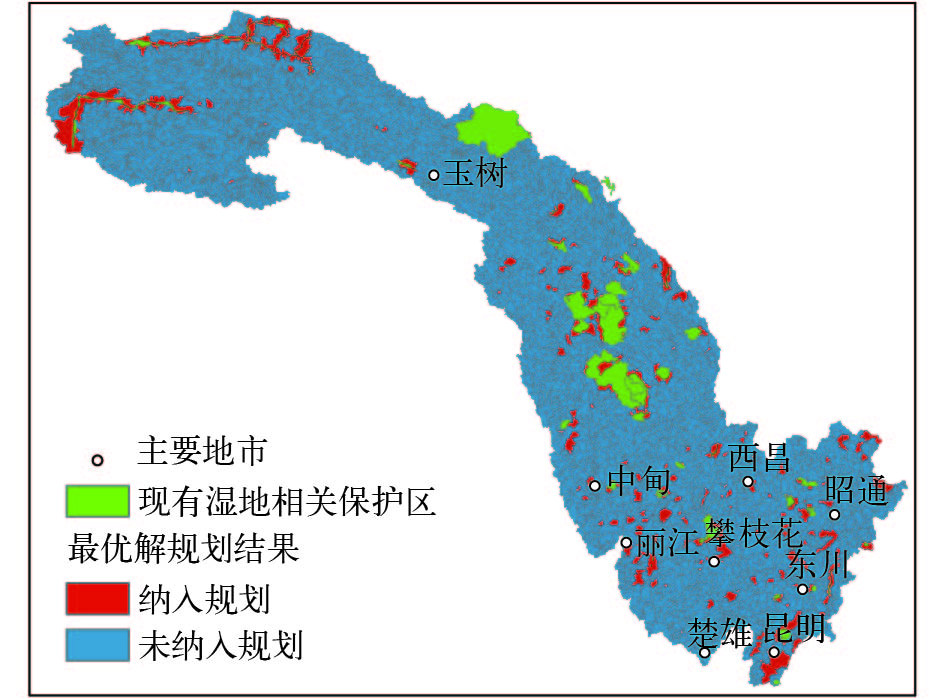FISH SYSTEMATIC CONSERVATION PLANNING IN THE JINSHA RIVER BASIN
-
摘要: 在全面整理和收集金沙江流域214种和亚种鱼类的分布及生物学特征的基础上, 采用系统保护规划的方法, 对流域内的鱼类保护进行了研究。首先, 我们确定了物种分布的范围。对分布较广的种类, 通过物种分布模型, 结合气候、河流景观、土地利用、土壤等环境因子, 预测物种在全流域内分布区; 对其余鱼类则直接使用采样点作为分布区。其次, 采用系统保护规划软件, 规划了流域内保护区网络。在规划过程中, 我们根据鱼类运动能力、分布广度和保护级别, 设定了不同的保护目标, 并对现有保护区的保护情况进行评估。结果表明, 模型的最优解选择了486个单元共47950 km2, 占所有规划单元数量的7.7%。而被现有湿地相关保护区保护的规划单元仅包含了127种鱼类, 占流域鱼类总数的59.3%, 且其中109种仍需增加保护面积, 说明现有保护区不足以保护流域内的鱼类; 在现有基础上, 保护区保护的规划单元面积至少需增加55.9%才能达成所设定的保护目标。Abstract: We compiled the distribution and traits of 214 fish species and subspecies in the Jinsha River basin to investigate systematic and effective conservation planning in the basin. First, we modelled the distribution of widespread species throughout the basin with environmental factors such as climate, riverscape, land-use, and soil type; we used the occurrences as the distribution for other species. We planned the protected area (PA) network with the Marxan software to determine the species-specific conservation targets (grouped by mobility, distribution range, and conservation status) and evaluate the protection status of the current wetlands PAs. The best solution selected 486 planning units (47950 km2) that was 7.7% of the total planning units. The current wetlands PAs was not enough for fish conservation, which shelters 59.3% of all fishes (127 species) and 109 species require additional conservation area. The planning units’ area protected by the wetlands PA need to expand 55.9% to reach our conservation target.
-
Keywords:
- Jinsha River /
- Systematic conservation planning /
- Species distribution modelling /
- Maxent /
- Marxan /
- Fish diversity
-
-
图 2 金沙江流域鱼类系统保护规划结果
a. 未锁定现有保护区的最优解; b. 未锁定现有保护区的规划单元选择频率; c. 锁定现有保护区的最优解; d. 锁定现有保护区的规划单元选择频率
Figure 2. Systematic conservation planning results for fishes of the Jinsha River basin
a. Best solution without locking-in the present conservation area; b. Planning units selection frequency without locking-in the present conservation area; c. Best solution with locking-in the present conservation area; d. Planning units selection frequency with locking-in the present conservation area
表 1 模型使用的环境变量及选择原因
Table 1 Environmental variables used in Maxent and rationales for selection
变量类型
Group变量名称
Variable name变量选择原因
Rationale气候
Climate平均日温差、等温性、最干旱月降雨、最热季降雨和降雨季度变化 气候影响整个生态系统过程 河流景观
Riverscape河流形态、坡度及其方差 与水文、栖息地数量等因素直接相关 土地覆盖
Land cover水域、稀疏植被、常绿阔叶林、落叶阔叶林、农田、针叶林、灌木、荒地、城市和洪泛区的面积 陆地生态系统类型与水生生态系统营养输入相关 土壤类型
Soil type土壤类型多样性 与植被类型、底质相关 表 2 保护级别对应及保护目标
Table 2 Conservation status and corresponding conservation targets
保护类别
Conservation status
in ChinaIUCN级别
IUCN status特有性
Endemicity保护目标
Conservation
targets (%)国家级 50 红皮书 CR 30 省级 EN 金沙江特有 20 VU 10 长江特有 5 其他鱼类 1 表 3 针对鱼类特性的保护目标调整参数
Table 3 Species-specific coefficients for adjusting conservation targets
大型或洄游鱼类
Large-size or
migratory fish中型鱼类
Medium-size fish小型鱼类
Small-size fish广布种
Widespread species1 w w2 非广布种
Other species1/w2 1/w 1 注: w为依据鱼类特性对保护目标进行调整的基数, 本研究中w=0.8Note: w is the base for species-specific adjustment of conservation targets, w = 0.8 in this study -
[1] Harrison I, Abell R, Darwall W, et al. The freshwater biodiversity crisis [J]. Science, 2018, 362(6421): 1369
[2] Carpenter S R, Stanley E H, Zanden M J V. State of the world’s freshwater ecosystems: physical, chemical, and biological changes [J]. Annual Review of Environment and Resources, 2011, 36(1): 75—99 doi: 10.1146/annurev-environ-021810-094524
[3] Dudgeon D, Arthington A H, Gessner M O, et al. Freshwater biodiversity: importance, threats, status and conservation challenges [J]. Biological Reviews, 2006, 81(2): 163—182 doi: 10.1017/S1464793105006950
[4] Linke S, Turak E, Nel J. Freshwater conservation planning: the case for systematic approaches [J]. Freshwater Biology, 2011, 56(1): 6—20 doi: 10.1111/fwb.2010.56.issue-1
[5] Dudgeon D. Asian river fishes in the Anthropocene: threats and conservation challenges in an era of rapid environmental change [J]. Journal of Fish Biology, 2011, 79(6): 1487—1524 doi: 10.1111/jfb.2011.79.issue-6
[6] Pressey R L, Ferrier S, Hager T C, et al. How well protected are the forests of north-eastern New South Wales? — Analyses of forest environments in relation to formal protection measures, land tenure, and vulnerability to clearing [J]. Forest Ecology and Management, 1996, 85(1-3): 311—333 doi: 10.1016/S0378-1127(96)03766-8
[7] Margules C R, Pressey R L. Systematic conservation planning [J]. Nature, 2000, 405(6783): 243—253 doi: 10.1038/35012251
[8] 张路, 欧阳志云, 徐卫华. 系统保护规划的理论、方法及关键问题. 生态学报, 2015, 35(4): 1284—1295 Zhang L, Ouyang Z Y, Xu W H. Theory,work frame and hot issues of systematic conservation planning [J]. Acta Ecologica Sinica, 2015, 35(4): 1284—1295
[9] Fiorella K, Cameron A, Sechrest W, et al. Methodological considerations in reserve system selection: A case study of Malagasy lemurs [J]. Biological Conservation, 2010, 143(4): 963—973 doi: 10.1016/j.biocon.2010.01.005
[10] Kremen C, Cameron A, Moilanen A, et al. Aligning conservation priorities across taxa in madagascar with high-resolution planning tools [J]. Science, 2008, 320(5873): 222—226 doi: 10.1126/science.1155193
[11] Peacock H, Bender D, Johnson S. Designing protected areas to conserve biodiversity: A case study of the Malagasy Lemurs [J]. Journal of Ecosystem and Ecography, 2014, 4(3): 51
[12] Fernandes L, Day J, Lewis A, et al. Establishing representative no-take areas in the great barrier reef: large-scale implementation of theory on marine protected areas [J]. Conservation Biology, 2005, 19(6): 1733—1744 doi: 10.1111/cbi.2005.19.issue-6
[13] Cowling R M, Pressey R L, Rouget M, et al. A conservation plan for a global biodiversity hotspot—the cape floristic region, South Africa [J]. Biological Conservation, 2003, 112(1-2): 191—216 doi: 10.1016/S0006-3207(02)00425-1
[14] Langford W T, Gordon A, Bastin L, et al. Raising the bar for systematic conservation planning [J]. Trends in Ecology & Evolution, 2011, 26(12): 634—640
[15] 吴江, 吴明森. 金沙江的鱼类区系. 四川动物, 1990, 9(3): 23—26 Wu J, Wu M S. Fish fauna of Jinsha River [J]. Sichuan Journal of Zoology, 1990, 9(3): 23—26
[16] 曹文宣. 有关长江流域鱼类资源保护的几个问题. 长江流域资源与环境, 2008, 17(2): 163—164 doi: 10.3969/j.issn.1004-8227.2008.02.001 Cao W X. A few issues about fishery resources conservation in the Yangtze Basin [J]. Resources and Environment in the Yangtze Basin, 2008, 17(2): 163—164 doi: 10.3969/j.issn.1004-8227.2008.02.001
[17] Winemiller K O, McIntyre P B, Castello L, et al. Balancing hydropower and biodiversity in the Amazon, Congo, and Mekong [J]. Science, 2016, 351(6269): 128—129 doi: 10.1126/science.aac7082
[18] Team G D. Geographic Resources Analysis Support System (GRASS) Software, Version 7.0. 2016, Open Source Geospatial Foundation
[19] Hermoso V, Kennard M J, Linke S. Integrating multidirectional connectivity requirements in systematic conservation planning for freshwater systems [J]. Diversity and Distributions, 2012, 18(5): 448—458 doi: 10.1111/ddi.2012.18.issue-5
[20] GBIF.org. GBIF Home Page. Accessed in 2017; Available from: http://gbif.org
[21] Eschmeyer W N, Fricke R, Laan R v d. Catalog of Fishes: Genera, Species, References. Accessed on 2017/05/15. 2017; Available from: http://researcharchive.calacademy.org/research/ichthyology/catalog/fishcatmain.asp
[22] Phillips S J, Dudík M, Schapire R E. [Internet] Maxent software for modeling species niches and distributions (Version 3.4.1). Available from url: http://biodiversityinformatics.amnh.org/open_source/maxent/. Accessed on 2017-4-15. 2017
[23] Radosavljevic A, Anderson R P. Making better Maxent models of species distributions: complexity, overfitting and evaluation [J]. Journal of Biogeography, 2014, 41(4): 629—643 doi: 10.1111/jbi.2014.41.issue-4
[24] Naimi B, Hamm N A S, Groen T A, et al. Where is positional uncertainty a problem for species distribution modelling [J]? Ecography, 2014, 37(2): 191—203 doi: 10.1111/j.1600-0587.2013.00205.x
[25] Varela S, Anderson R P, García-Valdés R, et al. Environmental filters reduce the effects of sampling bias and improve predictions of ecological niche models [J]. Ecography, 2014, 37(11): 1084—1091
[26] 黄心一, 李帆, 陈家宽. 基于系统保护规划法的长江中下游鱼类保护区网络规划. 中国科学: 生命科学, 2015, 45(12): 1244—1257 Huang X Y, Li F, Chen J K. Reserve network planning for fishes in the middle and lower Yangtze River basin by systematic conservation approaches [J]. Science China Life Sciences, 2015, 45(12): 1244—1257
[27] Liu C, White M, Newell G. Selecting thresholds for the prediction of species occurrence with presence-only data [J]. Journal of Biogeography, 2013, 40(4): 778—789 doi: 10.1111/jbi.2013.40.issue-4
[28] Ball I R, Possingham H P, Watts M. Marxan and Relatives: Software for Spatial Conservation Prioritisation [A]. In: Moilanen A, Wilson K A, Possingham H P (Eds.): In Spatial Conservation Prioritisation: Quantitative Methods and Computational Tools [C]. In: Moilanen A, Wilson K A, Possingham H P (Eds.). Oxford, UK: Oxford University Press. 2009, 185—195
[29] Ardron J A, Possingham H P, Klein C J. Marxan Good Practices Handbook, Version 2. 2010, Victoria, BC, Canada: Pacific Marine Analysis and Research Association
[30] Hermoso V, Linke S, Prenda J, et al. Addressing longitudinal connectivity in the systematic conservation planning of fresh waters [J]. Freshwater Biology, 2011, 56(1): 57—70
[31] Wildlife Conservation Society-WCS, Center for International Earth Science Information Network-CIESIN-Columbia University. Last of the Wild Project, Version 2, 2005 (LWP-2): Global Human Footprint Dataset (Geographic). 2005, NASA Socioeconomic Data and Applications Center (SEDAC): Palisades, NY
[32] Hermoso V, Cattarino L, Kennard M J, et al. Catchment zoning for freshwater conservation: refining plans to enhance action on the ground [J]. Journal of Applied Ecology, 2015, 52(4): 940—949 doi: 10.1111/1365-2664.12454
[33] UNEP-WCMC, IUCN. Protected Planet: The World Database on Protected Areas (WDPA). 2016, UNEP-WCMC and IUCN: Cambridge, UK
[34] Chen Y F, Chen Y Y, He D K. Biodiversity in the Yangtze River-fauna and distribution of fishes [J]. Journal of Ichthyology, 2002, 42(2): 152
[35] Heiner M, Higgins J, Li X, et al. Identifying freshwater conservation priorities in the Upper Yangtze River Basin [J]. Freshwater Biology, 2011, 56(1): 89—105
[36] 张路, 欧阳志云, 徐卫华, 等. 基于系统保护规划理念的长江流域两栖爬行动物多样性保护优先区评价. 长江流域资源与环境, 2010, 19(9): 1020—1028 Zhang L, Ouyang Z Y, Xu W H, et al. Biodiversity priority areas analysis for amphibians and reptiles in the Yangtze Basin based on systematic conservation planning idea [J]. Resources and Environment in the Yangtze Basin, 2010, 19(9): 1020—1028
[37] Faulks L K, Gilligan D M, Beheregaray L B. The role of anthropogenic vs. natural in-stream structures in determining connectivity and genetic diversity in an endangered freshwater fish, Macquarie perch (Macquaria australasica) [J]. Evolutionary Applications, 2011, 4(4): 589—601 doi: 10.1111/eva.2011.4.issue-4
[38] Lawrence D J, Larson E R, Liermann C A R, et al. National parks as protected areas for U.S. freshwater fish diversity [J]. Conservation Letters, 2011, 4(5): 364—371 doi: 10.1111/conl.2011.4.issue-5




 下载:
下载:

